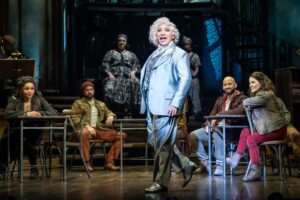★ ★ ★ ★
Hadestown the Musical is a popular adaptation of Orpheus and Eurydice, one of the Greek mythology’s alluring stories of love beyond the grave.
The story famously inspired the very first known opera ever written – L’Orfeo by Monteverdi in 1607 and was followed by others including Gluck’s popular and best-known opera Orpheus and Eurydice (1782). These operas libretto was based on the mythological subject included choruses and dancing. In HadesTown the elements of ‘chorus and choreographed movements are integral to the show, through all participants but in particular through Fates and the workers. The music echoes jazz, folk music, and lots more.
This musical production is pleasing and engaging. The mixed age audience in the auditorium loved every minute of it.
The story is told solely through Anaïs Mitchell’s lyrics and music – 32 songs, where the ‘Road to Hell’ opens and closes the show. There is no spoken dialogue. The music must move the plot along through the song. In this case it did so with minor limps. The audience basked in the music and the plot was a second wheel.
Mitchell, a gifted singer-songwriter, teamed up with the talented director and contributor Rachel Chavkin. The two developed the musical. Chavkin directed the show and Mitchell added lyrics and music to beef-up the original narrative. The two women secured the extraordinary success in 2019. The show received 14 Tony Award nominations and won eight of them, including Best Musical and Best Original Score.
HadesTown renders the ancient Greek myth into a modern format, to explore current social themes.
Eurydice (Grace Hodgett Young) is an impoverished young woman desperate to find a way to survive in a harsh world. She is a largely inactive character. Her existence is owed to the love Orpheus (Dónal Finn) has for her. In this narrative Orpheus is too busy ‘Working on a Song’ to notice the woman he loves until it is too late. Euridice is being challenged by the three Fates (Della Brown, Madelaine Charlemagne and Allie Daniel) in a three-part jazz harmony, and decides to sell her soul to Hades. She follows Hades to the Underworld.
Orpheus’s masterpiece song is rather intriguing. It is merely a musical scales on La-La-La. Dónal Finn, manages, with minor deviations, to produce what sounded in parts more like an alto castrato. It is possible that Mitchell is alluding to and saluting Monteverdi and Gluck.
The production failed to satisfactorily represent the love between Orpheus and Eurydice. These two characters are not fleshed out well enough to make them reletable characters. Their songs have a life of their own and drive the narrative.

In Hadestown, the reality is rather more dynamic and explores real-life characters than the bland idealised figures of myth. Hades, the god of the underworld, is a powerful industrialist, a controlling boss, wielding his authority to beguile and exploit the needy and weak members of society. Zachary James’s Hades lords over all others apart from his wife, Persephone, the queen of the Underworld, superbly performed by Gloria Onitiri . Onitiri’s Persephone is charming, at times weary and recoils when Hades exercises his authority, but she is always noble, attentive and wisely influence Hades. The performance of these two constitutes the heart of this production.
It is clear Hades loves Eurydice and she endures him.
Hermes, the ancient Greek god of trade, wealth, luck, and lots more, is used as a framing device for telling the story. At the outset we hear the song that what we are going to hear is “… an old song, And we’re going to sing it again … Maybe it will turn out this time.”
The Trinidadian Melanie La Barrie’s Hermes, is adorned in silver from top to toe. Her presence rules the stage until Hades and Persephone arrive on the scene. They dramatically dominate the narrative and the stage.
The cast and musicians secure an enjoyable evening’s entertainment. It is a show well worth seeing.
Venue: Lyric Theatre, London.
Running Time:Approx. 2 hours and 25 minutes including interval
Photo credit Marc Brenner

